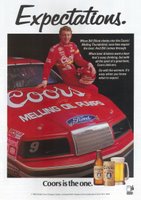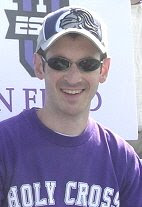
Back in December of 1997, I was vacationing in Las Vegas and decided to head up to Las Vegas Motor Speedway, because the
Richard Petty Driving Experience was holding classes at
LVMS that week.
The Richard Petty Driving Experience offers many courses. The rookie experience is a 3-hour course, you drive the car yourself, and the price starts at $399. I didn't want to take that much time and money out of my vacation in December.
So I opted for the "Riding Experience" which at the time cost $89.00, and believe me, was worth every penny. Basically, they mount a passenger seat into the stock car, and you ride along for a few laps with a professional instructor, at full speed.
It was an absolute thrill, I can hardly describe it in words. Just in the three laps in which we were at speed, I learned a ton about the cars, the tires, and the handling (and G-forces). I always talk to friends about the speeds, the skill of the drivers, the G-forces, and so forth, but this ride was unbelievable! Knowing what the drivers really do inside the car, and what it actually FEELS like at speed, especially in the turns, is something I wish every race fan could know.

(Photo note: Nellis AFB is behind LVMS's backstretch.)
My first taste of what the ride might be like was when I was watching the three race cars that were giving rides. They were out on the track running laps, warming up the tires. Also on the track (on the opposite end) were some of the driving school cars. They were running probably well over 120 mph for an average speed, but they looked so slow compared to the ride cars! The three ride cars were booking it. That was a hint of what was to come.

Several people were waiting in line for a ride. The three ride cars were being driven by Busch Series rookies
Mike Cope and
Matt Hutter, and an instructor with the school. Earlier, I had seen Matt Hutter standing around, before he got into the race car, and I thought I knew his face. I couldn't place it right away, but after ten or fifteen minutes, I finally realized that it was Hutter (although I wasn't completely sure it was him). I surprised myself that I recognized him. I must have remembered the face from Winston Cup Scene or an ARCA race or something. (Cope was also standing around the pit area earlier, but I didn't realize it was him. And he was in a Slim Jim driver's suit! Matt was in a plain gray driver's suit.)
I asked one of the employees for the school if the guy I thought was Matt Hutter actually was him, and he said yes, and seemed surprised that anyone recognized him. He said Matt would be surprised to know that someone recognized him. It turns out Matt Hutter and Mike Cope, teammates at the time for Cicci-Welliver Racing, were at the speedway preparing for the
Sam's Town 300 to be held there a couple of months later (and attended by me, in fact!)
So when it came to be my turn to do the ride, that guy with the school said, "Do you want to ride with your hero?" I thought that was pretty funny. Matt had just finished his warmup laps and was coming down pit road. So I got to ride with a real driver, not an instructor! I walked out onto pit road, and after Matt stopped the car, I climbed in. The guy with the school told Matt, "Guess what, this guy recognized you earlier." I couldn't really tell what Matt's reaction was, because he was wearing a helmet, but he was friendly about it. I think he was low-key, down-to-earth, just wanting to race.

As I got all strapped in and buckled up, Matt and I had a couple of minutes to talk while we were waiting for the other two ride cars to have their passengers buckled in. The engine was off, so we could hear each other fine, even though we both had helmets on. (By the way, I didn't have to wear a driving suit, which I thought was kind of odd.) Anyway, I told Matt that I couldn't believe I was going to be riding with someone who had driven at Talladega (in the ARCA race that October) and had done so well there. The guy with the school who was buckling me in said, "If you think this is exciting, you just wait till you get out on the track!" Matt said Talladega was fun to drive, and I said I had watched that race on TV, so he then quipped, "Let's hope this ride doesn't end up like Talladega." Of course, he crashed near the end at Talladega after running all day with the leaders. I laughed at his comment, and told him I wasn't worried about it, which oddly enough was the truth.
So finally he fired up the engine, which was thrilling on its own. We starting rolling down pit road, and the ride cars were not following a speed limit on pit road. We were flying off of pit road, and we just drove right up onto the banking and quickly got up to speed down the backstretch. The three ride cars were all running together, so it was almost like simulated racing. Before I got to the track, I was expecting the ride car would be running by itself. But having three ride cars together on the track, at full speed, was awesome! Matt actually took a little longer to get up to speed, so we were maybe ten or 15 car lengths behind the car in front of us (we were last in line of the three cars).

The first thing I really noticed was how hard they approach the turns. I always thought that at the end of the straightaways, the drivers paused after they got off the gas and before applying the brake. But we had the gas to the floor until the last possible moment entering the turn, then it was immediate hard braking, and back on the gas almost immediately thereafter. We FLEW through those turns. I also never realized how much the tires really MAKE the car stick to the track in the turns. I always thought that a track's banking played most of the role in supporting speed in the turns, with the car leaning against the bank and using that to keep the speeds up. But Vegas isn't a really high-banked track, and the tires got us through those turns. There was no skidding sound, but the grip was incredible. I now understand why tire wear and tire management is so critical in NASCAR racing. Without the grip we had, we would have just spun right into the wall.
Matt did a great job driving, and after two laps, he had driven hard and closed to within two car lengths of the car in front of us. To me, it looked like we were just a couple of feet behind the car in front, and I thought Matt was going to pass him, but actually it was at least a car length. I'd say we were averaging over 160 mph a lap, and top speed at least 180 at the end of the straights. It was just awesome. I highly recommend a Ride-Along to any NASCAR fan!
People have asked me how loud it was. It really wasn't that bad. Either I wasn't keyed into it, or the helmet muffled the sound.
My biggest surprise was how fast the ride cars ran. I was expecting a more leisurely pace, for safety reasons, but we couldn't have been that far off of top speed. At certain tracks (like Daytona), the rides aren't close to full speed, because full speed is "too fast." But at Vegas, "full speed" isn't as fast, so the ride offered a realistic sensation of the true racing speeds.

The ride was probably the most thrilling thing I've ever done in my life. I've never done a skydive or bungee jump, and I think those would be along the same lines, although perhaps less safe, because I felt pretty secure inside that race car.














